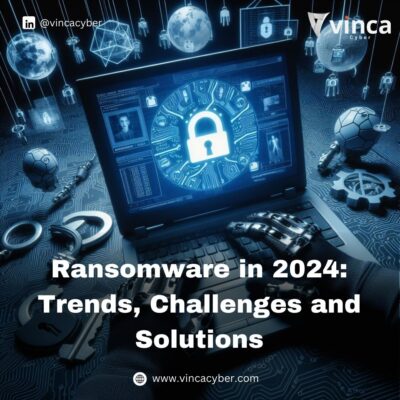Ransomware is a type of malicious software that encrypts the victim’s data and demands a ransom for its decryption. It is one of the most prevalent and damaging cyber threats, affecting millions of users and organizations worldwide. In this blog, we will explore the latest trends, challenges and solutions for ransomware in 2024, based on the predictions and insights from leading cybersecurity experts.
Trends
- Acceleration of opportunistic ransomware with zero-day exploits: Ransomware threat actors will continue to exploit newly discovered vulnerabilities in enterprise software, such as CitrixBleed, within 24 hours of their disclosure. They will also invest in genuine zero-day vulnerabilities, bypassing the need to wait for proof-of-concept code availability.
- Streamlining victim assessment and triage: Ransomware groups will use artificial intelligence (AI) to filter through, correlate and categorize the huge data sets collected from compromised networks. They will then manually select the optimal monetization method and attack mode for each target.
- Modernization of ransomware code: Ransomware groups will adopt more sophisticated and stealthy techniques to evade detection and response, such as DLL sideloading, living off the land and fileless malware.
- Continuous shift towards data theft over ransomware encryption: Ransomware groups will increasingly rely on data exfiltration and extortion as a primary revenue source, rather than encryption and decryption. They will threaten to expose or sell the stolen data to the highest bidder, or use it for further attacks.
- Elevation of ransomware groups to higher sophistication: Ransomware groups will evolve into more organized and professional entities, with clear roles, responsibilities and hierarchies. They will also collaborate with other cybercriminals, such as initial access brokers, data brokers and money launderers, to optimize their operations.
- Disruption of state-sponsored techniques by ransomware groups: Ransomware groups will leverage the tools and techniques traditionally associated with state-sponsored threat actors, such as advanced persistent threats (APTs), to target critical infrastructure and high-value sectors, such as healthcare, energy and finance.
Challenges
- Lack of awareness and preparedness: Many users and organizations are still unaware of the ransomware threat, or lack the necessary resources and skills to prevent, detect and respond to it. They also face the dilemma of whether to pay the ransom or not, which may have legal, ethical and security implications.
- Regulatory and legal gaps: There is a lack of consistent and effective regulations and laws to combat ransomware, especially across different jurisdictions and regions. There is also a need for more cooperation and coordination among law enforcement agencies, governments and private sector actors to disrupt the ransomware ecosystem.
- Technical and operational complexity: Ransomware attacks are becoming more complex and diverse, requiring more sophisticated and tailored solutions. There is also a challenge of balancing security and usability, as some security measures may affect the performance and functionality of the systems and applications.
Solutions
- Education and awareness: Users and organizations need to be educated and informed about the ransomware threat, and how to protect themselves from it. They need to follow the best practices of cybersecurity hygiene, such as using strong passwords, updating software, backing up data, avoiding suspicious links and attachments, and reporting incidents.
- Prevention and protection: Users and organizations need to implement effective security measures to prevent and protect themselves from ransomware attacks, such as firewalls, antivirus, endpoint detection and response (EDR), network segmentation, encryption, multifactor authentication and application whitelisting.
- Detection and response: Users and organizations need to have the capabilities and tools to detect and respond to ransomware attacks, such as security information and event management (SIEM), threat intelligence, incident response, disaster recovery and business continuity.
- Collaboration and cooperation: Users and organizations need to collaborate and cooperate with each other, and with external stakeholders, such as security vendors, researchers, law enforcement agencies, governments and regulators, to share information, resources and best practices, and to disrupt the ransomware ecosystem.
How Vinca Cyber Can Help Your Organization
Vinca Cyber is a global cybersecurity services and products company that provides innovative and comprehensive solutions for ransomware prevention, protection, detection and response. Vinca Cyber has a team of experienced and certified cybersecurity experts who can help you achieve 360° cyber resilience with their zero-trust approach, managed security services, 360° cyber security assessment service, phishing simulation and security awareness, and cloud security consulting. Vinca Cyber is also a trusted partner of leading security vendors and technologies, such as Microsoft, Accops, EC Council, Netskope and more. Whether you need to secure your network, applications, cloud, data, webapp or endpoint, Vinca Cyber can help you with their security assured, transparent and tailored services. Contact Vinca Cyber today and get a free consultation on how to protect your organization from ransomware and other cyber threats.

